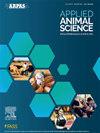Liver abscess bacterial pathogens in healthy liver tissues, normal tissues of abscessed livers, and corresponding ruminal epithelial tissues of beef-on-dairy cattle*
IF 1.5
Q3 AGRICULTURE, DAIRY & ANIMAL SCIENCE
引用次数: 0
Abstract
Objective
Our objective was to determine the prevalence of Fusobacterium necrophorum ssp. necrophorum and ssp. funduliforme, Trueperella pyogenes, Salmonella enterica, and Escherichia coli and quantify F. necrophorum in parenchymal tissues of healthy livers and abscessed livers and ruminal epithelial tissues of beef-on-dairy cattle.
Materials and Methods
Samples, collected at slaughter, included 107 healthy livers and 110 abscessed livers, and 101 matched ruminal tissues each from cattle with healthy or abscessed livers. Culture methods to isolate the bacterial species and quantitative PCR to determine prevalence and concentrations of F. necrophorum were used. Statistical analyses included Fisher’s exact test for prevalence and ANOVA for bacterial concentration comparisons.
Results and Discussion
Culture and quantitative PCR data indicated prevalence of the 4 species of pathogens and E. coli in tissues of healthy livers and abscessed livers. The prevalences of the 2 subspecies were greater in ruminal than liver tissues. Fusobacterium necrophorum ssp. funduliforme was the dominant subspecies in both tissues, likely because it is the most prevalent subspecies in ruminal contents of cattle. Only one healthy liver yielded T. pyogenes. Both tissue types yielded S. enterica, and the dominant serotype was Montevideo. The prevalence of E. coli, an indicator of bacterial flow from the gut, ranged from 55% to 100%. Approximately, 8% of the liver tissues had quantifiable concentrations of F. necrophorum. More ruminal tissues from cattle with abscessed livers (76%) had quantifiable concentrations of the 2 subspecies than those from cattle with healthy livers (57.4%). Our data suggest that healthy livers harbor pathogens and ruminal tissues serve as a reservoir of pathogens that enter the portal blood.
Implications and Applications
Tissue-embedded pathogens exist in healthy livers, normal regions of abscessed livers, and ruminal epithelium of cattle. There is likely a threshold of concentration required to initiate abscess development, and delineating factors that trigger this process may aid in novel intervention strategies.
肉牛健康肝组织、脓肿肝正常组织及相应瘤胃上皮组织中的肝脓肿细菌病原体*
目的了解necrophorum梭杆菌的流行情况。Necrophorum和ssp。在健康的肝脏、脓肿的肝脏和奶牛的瘤胃上皮组织的实质组织中定量地检测出坏死性肉毒杆菌、化脓性真杆菌、肠炎沙门氏菌和大肠杆菌。材料与方法在屠宰时收集健康肝脏107例,脓肿肝脏110例,健康肝脏和脓肿肝脏各101例。采用培养法分离细菌种类,采用定量PCR法测定necrophorum的流行率和浓度。统计分析包括Fisher的流行率精确检验和细菌浓度比较的方差分析。结果与讨论培养和定量PCR结果显示,4种病原菌和大肠杆菌在健康肝脏和脓肿肝脏组织中普遍存在。2个亚种在瘤胃中的流行率高于肝组织。坏死梭杆菌。在这两个组织中,底状菌是优势亚种,可能是因为它是牛瘤胃内容物中最普遍的亚种。只有一个健康的肝脏产生了化脓性肠杆菌。两种组织类型均产生肠球菌,主要血清型为蒙得维的亚。大肠杆菌的流行率从55%到100%不等,大肠杆菌是肠道细菌流动的一个指标。大约8%的肝组织有可量化的坏死梭菌浓度。肝脏脓肿牛的瘤胃组织(76%)比肝脏健康牛的瘤胃组织(57.4%)含有更多的这两个亚种的可量化浓度。我们的数据表明,健康的肝脏含有病原体,而瘤胃组织是病原体进入门静脉血液的储存库。组织包埋病原体存在于牛的健康肝脏、脓肿肝脏的正常区域和瘤胃上皮中。引发脓肿发展可能需要一个浓度阈值,描述触发这一过程的因素可能有助于制定新的干预策略。
本文章由计算机程序翻译,如有差异,请以英文原文为准。
求助全文
约1分钟内获得全文
求助全文

 求助内容:
求助内容: 应助结果提醒方式:
应助结果提醒方式:


